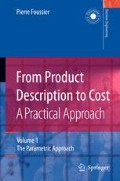Summary
Cost measurement is not a standard term. Accountants,who are the experts in this domain, call it “cost accounting”. But this word does not speak so much outside their world. What we want to do is to put a cost value on all the “objects” we manufacture, from observations of the efforts devoted to the manufacturing process. Any technician or engineer knows what measurement means: it is part of their day-to-day activity. The same thing has to be done for costs and it is the reason we use the word “cost measurement”.
No engineer will use a figure resulting from measurement without being able to make a judgment on its value: does this figure correctly reflect the reality? The situation is similar for the cost analyst, even if the conditional tense has still to be used; no cost analyst should use a cost value without asking the question: does this cost value effectively represent the effort which was spent to manufacture this product?
This implies first that the cost analyst knows how costs are measured. Unfortunately there are different ways to measure a cost, and the results of these different ways cannot be compared, up to the point they may be completely different.
The cost analyst should therefore understand these different ways and draw consequences of this knowledge in order not to make mistakes.
He/she should also not forget that behind the theory of cost measurement there are human beings who can make mistakes and misinterpretations of the rules, or, in the worst cases, have an interest in distorting cost values when it is possible.
Parametric cost estimating is a powerful tool for checking the reliability of cost figures, just because its main objective is to compare costs and consequently it may reveal inconsistencies. In some organizations, one of the first purposes of using parametric cost estimating is precisely to “clean” the databases.
This question is asked in a completely different way when prices are compared. It is much more difficult, but possible.
Cost estimating, as we mentioned it in the previous chapter, is based (whatever the technique used to prepare it) on a comparison with previous experiences.
The first thing to do is then to accumulate cost information from different objects or situations. The problem with cost,which has no comparison with other subjects, is that there is no way to directly “measure” cost; cost measurement is always an indirect process, sometimes extremely indirect.
Access this chapter
Tax calculation will be finalised at checkout
Purchases are for personal use only
Preview
Unable to display preview. Download preview PDF.
Rights and permissions
Copyright information
© 2006 Springer-Verlag London Limited
About this chapter
Cite this chapter
(2006). Cost Measurement. In: From Product Description to Cost: A Practical Approach. Decision Engineering. Springer, London. https://doi.org/10.1007/1-84628-335-3_2
Download citation
DOI: https://doi.org/10.1007/1-84628-335-3_2
Publisher Name: Springer, London
Print ISBN: 978-1-85233-973-9
Online ISBN: 978-1-84628-335-2
eBook Packages: EngineeringEngineering (R0)

